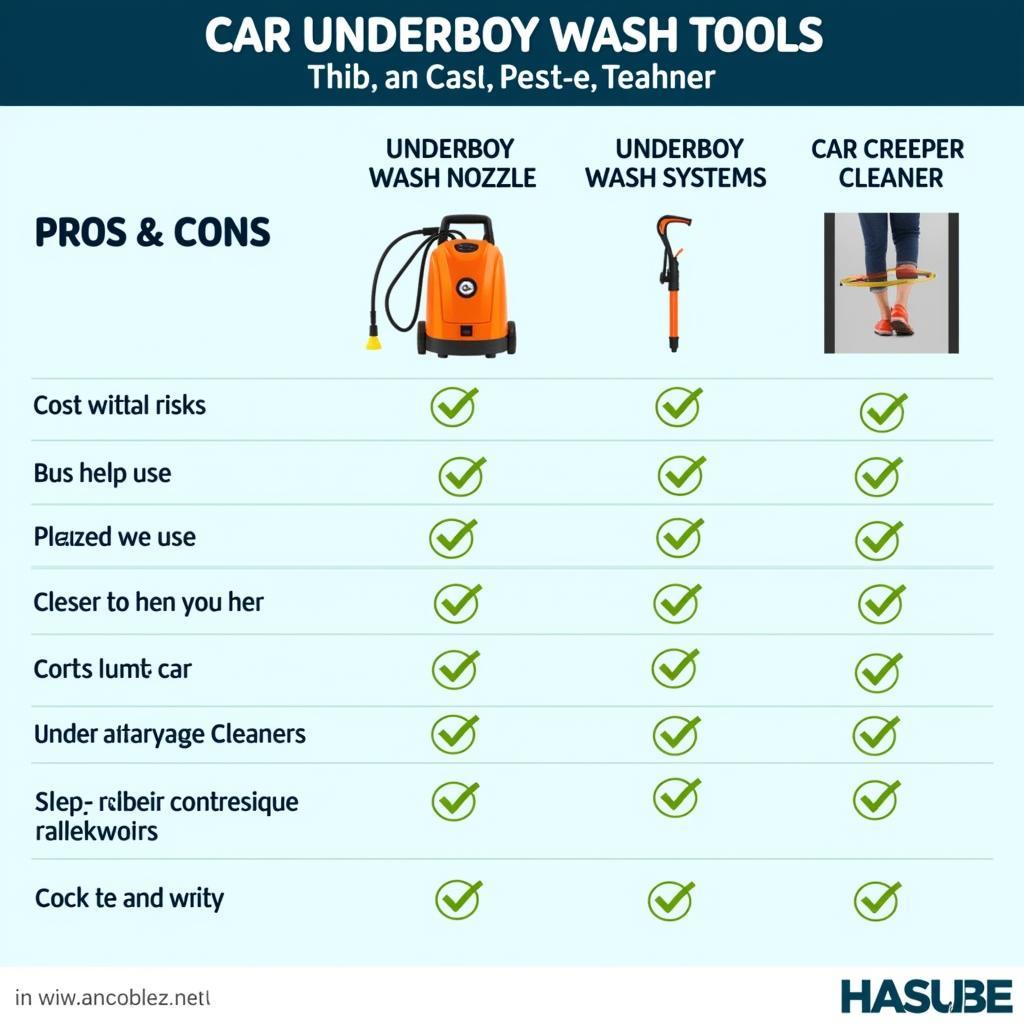Car Underbody Wash Tools are essential for maintaining your vehicle’s health and longevity. Neglecting this often-overlooked area can lead to rust, corrosion, and ultimately, expensive repairs. Choosing the right underbody wash tool can be the difference between a quick, efficient clean and a frustrating, ineffective experience. This guide will cover everything you need to know about selecting and using the best car underbody wash tool for your needs.
Why is Underbody Washing Important?
Road salt, grime, mud, and other debris accumulate on your car’s undercarriage, creating a corrosive environment that can damage vital components. Regular underbody washing removes these harmful substances, protecting your investment and ensuring your vehicle stays in top condition. It’s particularly important in areas with harsh winters where road salt is heavily used. Not only does underbody washing protect against rust, but it also improves fuel efficiency by reducing drag caused by built-up grime.
Types of Car Underbody Wash Tools
Choosing the right car underbody wash tool depends on your specific needs and budget. There are several options available, each with its own advantages and disadvantages.
Pressure Washers
Pressure washers are a popular choice for underbody cleaning due to their powerful spray. They can effectively blast away stubborn dirt and grime. However, using a pressure washer requires caution, as excessive pressure can damage delicate undercarriage components.
Underbody Wash Nozzles
These specialized nozzles attach to a standard garden hose and provide an angled spray to reach the undercarriage. They are a more affordable option than pressure washers and are less likely to cause damage.
Car Creeper Wash Systems
For those who prefer a hands-on approach, car creeper wash systems offer a convenient way to clean the undercarriage while lying down. These systems typically include a wand with a rotating brush and a detergent dispenser.
Dedicated Undercarriage Cleaners
Some companies offer dedicated undercarriage cleaning systems that combine high-pressure water with specialized cleaning solutions. These systems are often used by professional detailers and offer the most thorough cleaning.
 Car Underbody Wash Tool Comparison Chart
Car Underbody Wash Tool Comparison Chart
How to Use a Car Underbody Wash Tool Effectively
Regardless of the tool you choose, following the correct procedure is essential for a thorough and safe underbody wash.
- Prepare Your Vehicle: Park your car on a level surface and ensure the engine is cool.
- Rinse the Undercarriage: Use a garden hose to remove loose dirt and debris.
- Apply Cleaning Solution (if applicable): If using a detergent or cleaning solution, apply it according to the manufacturer’s instructions.
- Wash the Undercarriage: Use your chosen tool to thoroughly clean the entire undercarriage, paying attention to hard-to-reach areas.
- Rinse Thoroughly: Rinse away all traces of cleaning solution and debris.
- Dry the Undercarriage (optional): Allowing the undercarriage to air dry is generally sufficient, but you can use a leaf blower or compressed air for faster drying.
Choosing the Right Tool for Your Needs
“Choosing the right tool comes down to balancing your budget, available space, and how much elbow grease you’re willing to put in,” says Bob Johnson, a seasoned auto mechanic with over 20 years of experience. “For occasional cleaning, a simple underbody wash nozzle might be sufficient. However, for more frequent and thorough cleaning, a pressure washer or dedicated system is a worthwhile investment.”
Maintaining Your Car Underbody Wash Tool
Proper maintenance will extend the life of your car underbody wash tool. Regularly clean and inspect your equipment for any signs of wear and tear. For pressure washers, ensure the filters are clean and the hoses are in good condition.
Conclusion
Investing in a car underbody wash tool is a smart move for any car owner. Regular underbody washing protects your vehicle from corrosion, extends its lifespan, and even improves fuel efficiency. By understanding the different types of car underbody wash tools available and following the correct cleaning procedures, you can keep your car’s undercarriage in pristine condition for years to come.
FAQ
- How often should I wash my car’s undercarriage? It’s recommended to wash your car’s undercarriage every few months, or more frequently during winter in areas with heavy road salt use.
- Can I use a regular garden hose for underbody washing? While a garden hose can remove loose debris, it’s not as effective as specialized underbody wash tools.
- Is it safe to use a pressure washer on my car’s undercarriage? Yes, but use caution. Excessive pressure can damage delicate components.
- What type of cleaning solution should I use? Use a car wash soap specifically designed for undercarriage cleaning.
- How long does it take to wash a car’s undercarriage? The time required depends on the tool used and the level of soiling, but it typically takes between 15 and 30 minutes.
- Can I wash my car’s undercarriage at home? Yes, you can easily wash your car’s undercarriage at home using the right tools and techniques.
- What are the signs of undercarriage damage? Signs of damage include visible rust, corrosion, and loose or damaged components.
Need Help with Your Car Diagnostics?
For any car diagnostic support, contact us via WhatsApp: +1(641)206-8880, Email: [email protected] or visit us at 910 Cedar Lane, Chicago, IL 60605, USA. We have a 24/7 customer support team ready to assist you. You can also find more helpful articles like this on DiagFixPro.com, covering a wide range of car maintenance and repair topics.

Leave a Reply